steering MERCEDES-BENZ SLK ROADSTER 2008 Owners Manual
[x] Cancel search | Manufacturer: MERCEDES-BENZ, Model Year: 2008, Model line: SLK ROADSTER, Model: MERCEDES-BENZ SLK ROADSTER 2008Pages: 273, PDF Size: 4.42 MB
Page 11 of 273
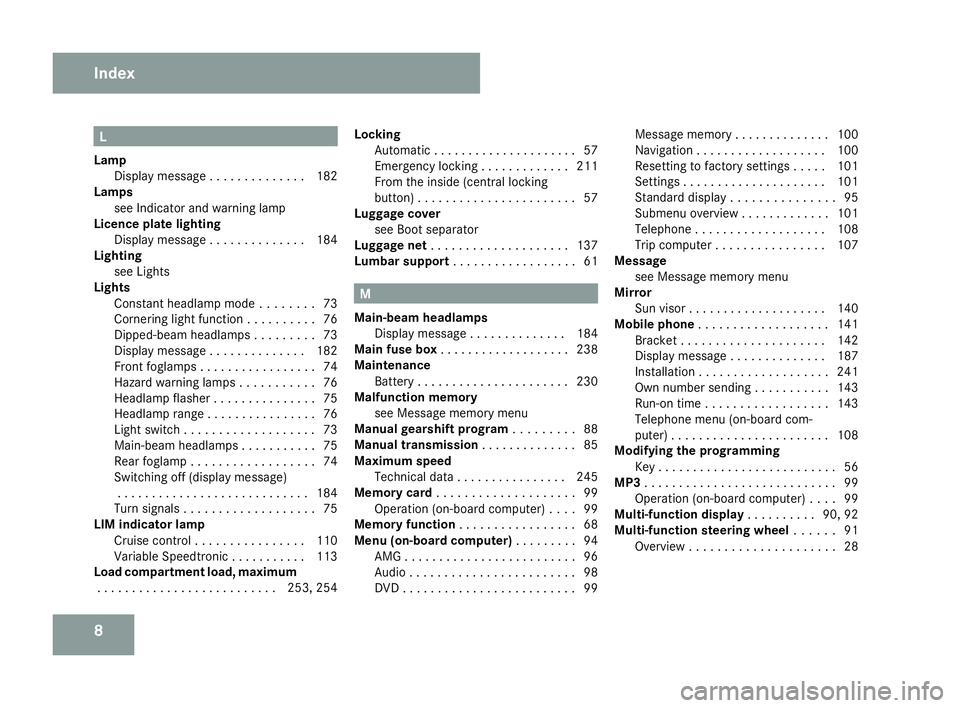
8 L
Lam p
Display message . . . . . . . . . . . . . .182
Lamps
see Indicator and warning lamp
Licence plate lighting
Display message . . . . . . . . . . . . . .184
Lighting
see Lights
Lights
Constant headlamp mode . . . . . . . .73
Cornering light function . . . . . . . . . .76
Dipped-beam headlamps . . . . . . . . .73
Display message . . . . . . . . . . . . . .182
Front foglamp s.. . . . . . . . . . . . . . . .74
Hazard warning lamps . . . . . . . . . . .76
Headlamp flasher . . . . . . . . . . . . . . .75
Headlamp range . . . . . . . . . . . . . . . .76
Light switch . . . . . . . . . . . . . . . . . . .73
Main-beam headlamps . . . . . . . . . . .75
Rear foglamp . . . . . . . . . . . . . . . . . .74
Switching off (display message) . . . . . . . . . . . . . . . . . . . . . . . . . . . .184
Turn signals . . . . . . . . . . . . . . . . . . .75
LIM indicator lam p
Cruise control . . . . . . . . . . . . . . . .110
Variable Speedtronic . . . . . . . . . . .113
Load compartment load, maximum
. . . . . . . . . . . . . . . . . . . . . . . . . .253, 254 Locking
Automatic . . . . . . . . . . . . . . . . . . . . .57
Emergency locking . . . . . . . . . . . . .211
From the inside (central locking
button) . . . . . . . . . . . . . . . . . . . . . . .57
Luggage cover
see Boot separator
Luggage net . . . . . . . . . . . . . . . . . . . .137
Lumbar support . . . . . . . . . . . . . . . . . .61 M
Main-beam headlamps Display message . . . . . . . . . . . . . .184
Main fuse box . . . . . . . . . . . . . . . . . . .238
Maintenanc e
Battery . . . . . . . . . . . . . . . . . . . . . .230
Malfunction memory
see Message memory menu
Manual gearshift program . . . . . . . ..88
Manual transmissio n. . . . . . . . . . . . . .85
Maximum spee d
Technical data . . . . . . . . . . . . . . . .245
Memory card . . . . . . . . . . . . . . . . . . . .99
Operation (on-board computer) . . . .99
Memory functio n. . . . . . . . . . . . . . . . .68
Menu (on-board computer) . . . . . . . ..94
AMG . . . . . . . . . . . . . . . . . . . . . . . . .96
Audio . . . . . . . . . . . . . . . . . . . . . . . .98
DVD . . . . . . . . . . . . . . . . . . . . . . . . .99 Message memory . . . . . . . . . . . . .
.100
Navigation . . . . . . . . . . . . . . . . . . .100
Resetting to factory settings . . . . .101
Settings . . . . . . . . . . . . . . . . . . . . .101
Standard displa y.. . . . . . . . . . . . . .95
Submenu overview . . . . . . . . . . . . .101
Telephone . . . . . . . . . . . . . . . . . . .108
Trip computer . . . . . . . . . . . . . . . .107
Message
see Message memory menu
Mirror
Sun viso r.. . . . . . . . . . . . . . . . . . .140
Mobile phone . . . . . . . . . . . . . . . . . . .141
Bracket . . . . . . . . . . . . . . . . . . . . .142
Display message . . . . . . . . . . . . . .187
Installatio n.. . . . . . . . . . . . . . . . . .241
Own number sending . . . . . . . . . . .143
Run-on time . . . . . . . . . . . . . . . . . .143
Telephone menu (on-board com-
puter) . . . . . . . . . . . . . . . . . . . . . . .108
Modifying the programming
Key . . . . . . . . . . . . . . . . . . . . . . . . . .56
MP3 . . . . . . . . . . . . . . . . . . . . . . . . . . . .99
Operation (on-board computer) . . . .99
Multi-function display . . . . . . . . ..90, 92
Multi-function steering wheel . . . . ..91
Overview . . . . . . . . . . . . . . . . . . . . .28 Index
171_AKB; 3; 4, en-G
B
vpfaff7, 2007-11-13T10:50:25+01:00 - Seite
8
Page 14 of 273
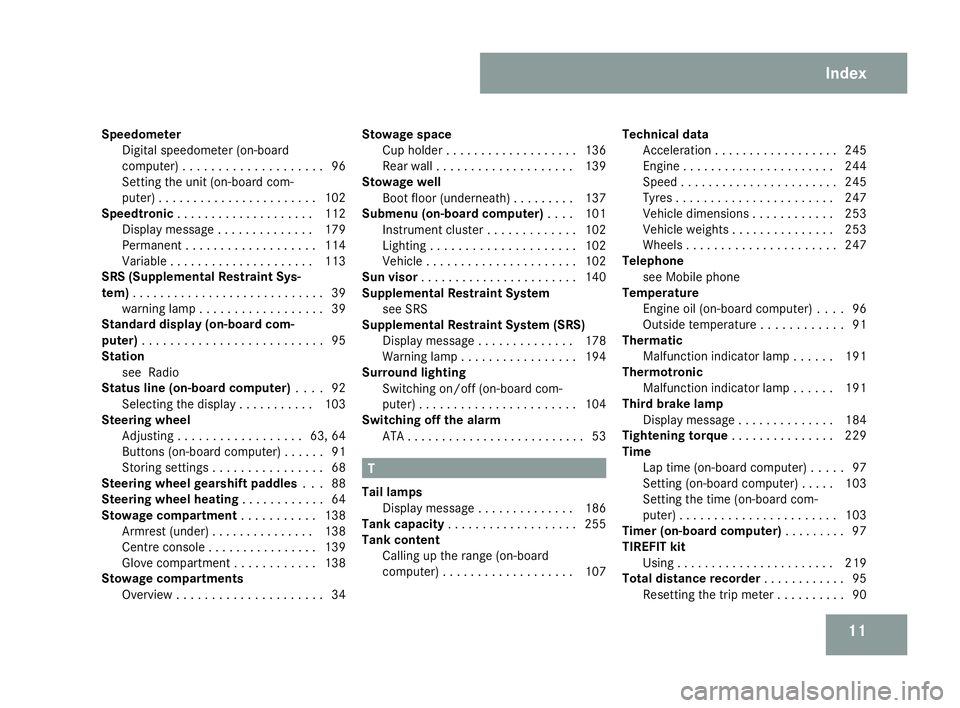
11
Speedometer
Digital speedometer (on-board
computer) . . . . . . . . . . . . . . . . . . . .96
Setting the unit (on-board com-
puter) . . . . . . . . . . . . . . . . . . . . . . .102
Speedtronic . . . . . . . . . . . . . . . . . . . .112
Display message . . . . . . . . . . . . . .179
Permanent . . . . . . . . . . . . . . . . . . .114
Variabl e.. . . . . . . . . . . . . . . . . . . .113
SRS (Supplemental Restraint Sys-
tem) . . . . . . . . . . . . . . . . . . . . . . . . . . . .39
warning lamp . . . . . . . . . . . . . . . . . .39
Standard display (on-board com-
puter) . . . . . . . . . . . . . . . . . . . . . . . . . .95
Station see Radio
Status line (on-board computer) . . ..92
Selecting the display . . . . . . . . . . .103
Steering wheel
Adjusting . . . . . . . . . . . . . . . . . .63, 64
Buttons (on-board computer) . . . . . .91
Storing settings . . . . . . . . . . . . . . . .68
Steering wheel gearshift paddles . ..8 8
Steering wheel heating . . . . . . . . . . ..64
Stowage compartment . . . . . . . . . ..138
Armrest (under) . . . . . . . . . . . . . . .138
Centre console . . . . . . . . . . . . . . . .139
Glove compartment . . . . . . . . . . . .138
Stowage compartments
Overview . . . . . . . . . . . . . . . . . . . . .34 Stowage space
Cup holder . . . . . . . . . . . . . . . . . . .136
Rear wall . . . . . . . . . . . . . . . . . . . .139
Stowage well
Boot floor (underneath) . . . . . . . . .137
Submenu (on-board computer) . . ..1 01
Instrument cluster . . . . . . . . . . . . .102
Lighting . . . . . . . . . . . . . . . . . . . . .102
Vehicle . . . . . . . . . . . . . . . . . . . . . .102
Sun viso r. . . . . . . . . . . . . . . . . . . . . . .140
Supplemental Restraint Syste m
see SRS
Supplemental Restraint System (SRS)
Display message . . . . . . . . . . . . . .178
Warning lamp . . . . . . . . . . . . . . . . .194
Surround lighting
Switching on/off (on-board com-
puter) . . . . . . . . . . . . . . . . . . . . . . .104
Switching off the alarm
ATA . . . . . . . . . . . . . . . . . . . . . . . . . .53 T
Tail lamps Display message . . . . . . . . . . . . . .186
Tank capacity . . . . . . . . . . . . . . . . . . .255
Tank content Calling up the range (on-board
computer) . . . . . . . . . . . . . . . . . . .107 Technical data
Acceleration . . . . . . . . . . . . . . . . . .245
Engine . . . . . . . . . . . . . . . . . . . . . .244
Speed . . . . . . . . . . . . . . . . . . . . . . .245
Tyres . . . . . . . . . . . . . . . . . . . . . . .247
Vehicle dimensions . . . . . . . . . . . .253
Vehicle weights . . . . . . . . . . . . . . .253
Wheels . . . . . . . . . . . . . . . . . . . . . .247
Telephone
see Mobile phone
Temperature
Engine oil (on-board computer) . . . .96
Outside temperature . . . . . . . . . . . .91
Thermatic
Malfunction indicator lamp . . . . . .191
Thermotroni c
Malfunction indicator lamp . . . . . .191
Third brake lamp
Display message . . . . . . . . . . . . . .184
Tightening torque . . . . . . . . . . . . . ..229
Time Lap time (on-board computer) . . . . .97
Setting (on-board computer) . . . . .103
Setting the time (on-board com-
puter) . . . . . . . . . . . . . . . . . . . . . . .103
Timer (on-board computer) . . . . . . . ..97
TIREFIT kit Using . . . . . . . . . . . . . . . . . . . . . . .219
Total distance recorder . . . . . . . . . . ..95
Resetting the trip meter . . . . . . . . . .90 Index
171_AKB; 3; 4, en-G
B
vpfaff7, 2007-11-13T10:50:25+01:00 - Seite 11
Page 20 of 273
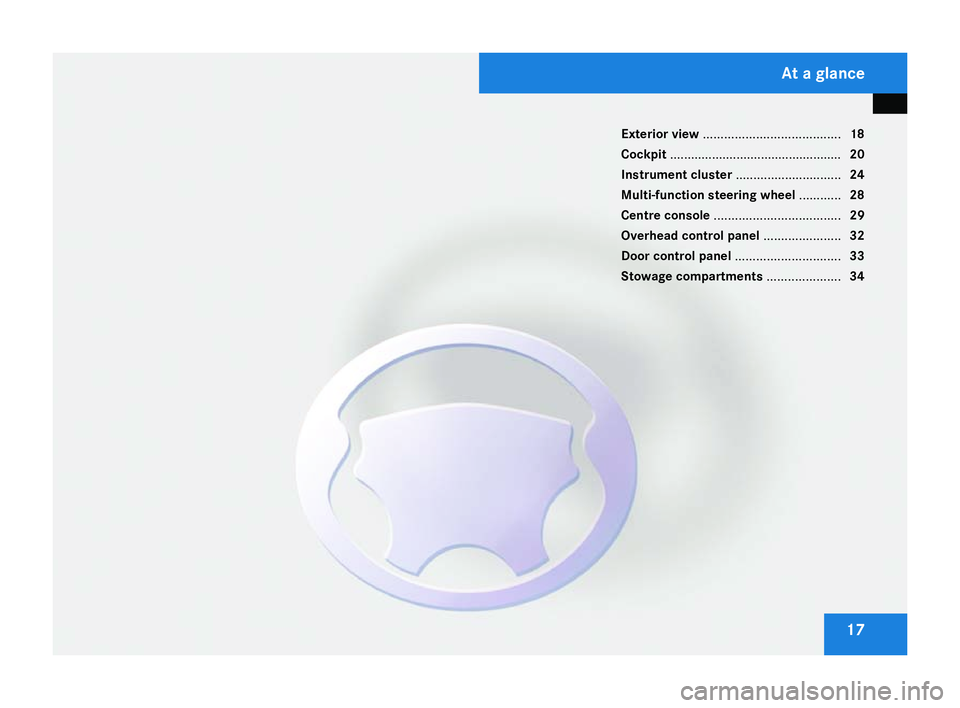
17
Exterior view
....................................... 18
Cockpit ................................................ .20
Instrument cluster ..............................24
Multi-function steering wheel ............28
Centre console .................................... 29
Overhead control panel ......................32
Door control panel .............................. 33
Stowage compartments .....................34 At a glance
171_AKB; 3; 4, en-GB
vpfaff7
, 2007-11-13T10:50:25+01:00 - Seite 17
Page 24 of 273
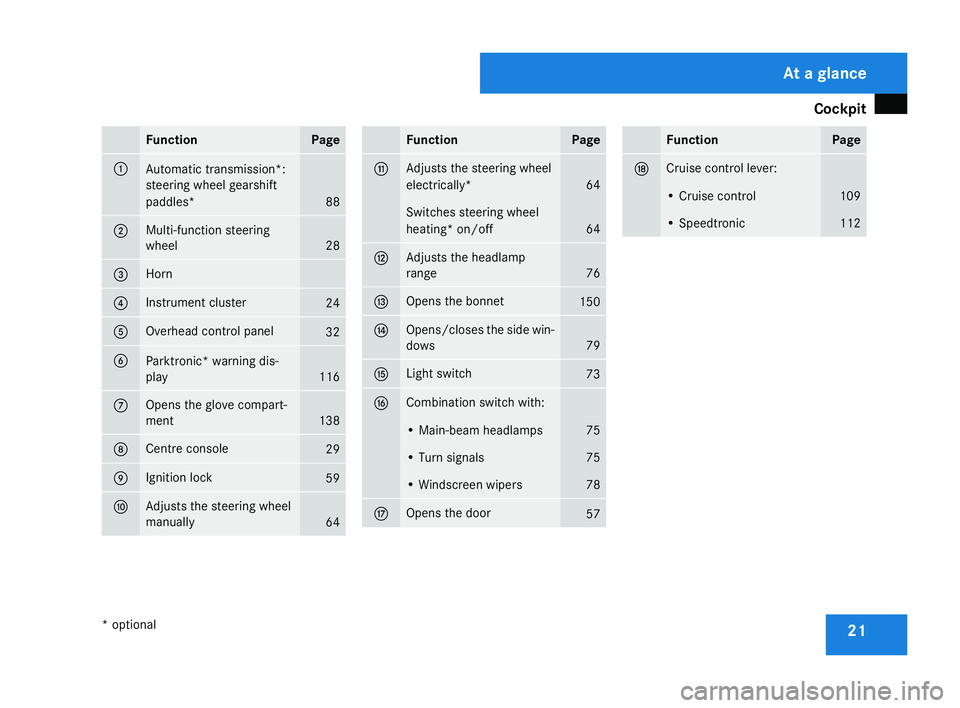
Cockpit
21Function Page
1
Automatic transmission*
:
steering wheel gearshift
paddles* 88
2 Multi-function steering
wheel
28
3 Horn
4 Instrument cluster
24
5 Overhead control panel
32
6
Parktronic* warning dis-
play
116
7 Opens the glove compart-
ment
138
8 Centre console
29
9 Ignition lock
59
a Adjusts the steering whee
l
manually 64 Function Page
b Adjusts the steering whee
l
electrically* 64
Switches steering wheel
heating* on/off 64
c Adjusts the headlamp
range
76
d Opens the bonnet
150
e Opens/closes the side win-
dows
79
f Light switch
73
g Combination switch with:
• Main-beam headlamps 75
• Turn signals 75
• Windscreen wiper
s 78
h Opens the door
57 Function Page
j Cruise control lever:
• Cruise control 10
9 • Speedtronic 11
2 At a glance
* optional
171_AKB; 3; 4, en-G
B
vpfaff7, 2007-11-13T10:50:25+01:00 - Seite 21
Page 26 of 273
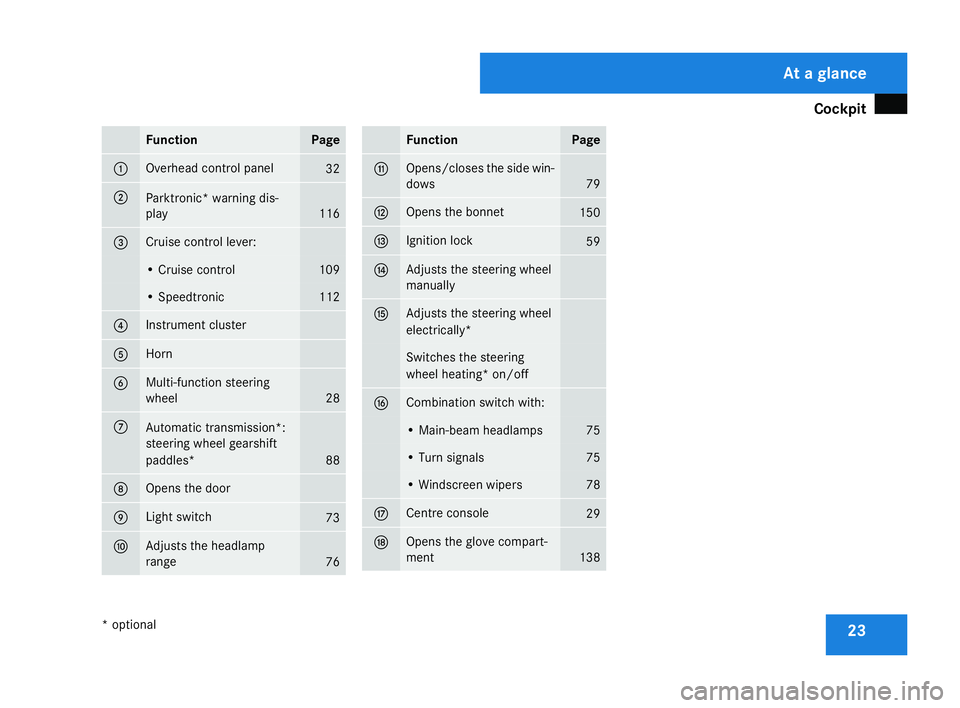
Cockpit
23Function Page
1 Overhead control panel
32
2
Parktronic* warning dis-
play
116
3 Cruise control lever:
• Cruise control 10
9 • Speedtronic 11
2 4 Instrument cluster
5 Horn
6 Multi-function steering
wheel
28
7
Automatic transmission*
:
steering wheel gearshift
paddles* 88
8 Opens the door
9 Light switch
73
a Adjusts the headlamp
range
76 Functio
n Page
b Opens/closes the side win-
dows
79
c Opens the bonnet
150
d Ignition lock
59
e Adjusts the steering whee
l
manually f Adjusts the steering whee
l
electrically* Switches the steering
wheel heating* on/off g Combination switch with:
• Main-beam headlamps 75
• Turn signals 75
• Windscreen wiper
s 78
h Centre console
29
j Opens the glove compart-
ment 138 At a glance
* optional
171_AKB; 3; 4, en-GB
vpfaff7,
2007-11-13T10:50:25+01:00 - Seite 23
Page 31 of 273
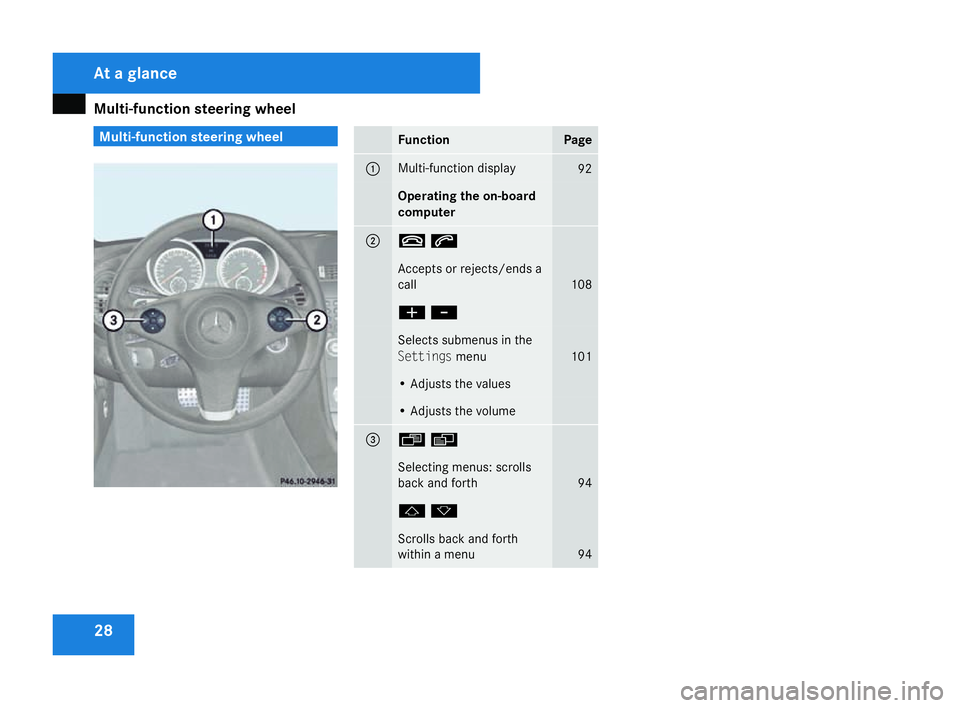
Multi-function steering wheel
28 Multi-function steering wheel
Function Pag
e 1 Multi-function display
92
Operating the on-board
computer
2 ts
Accepts or rejects/ends
a
call 108
æ
- Selects submenus in the
Settings
menu 101
• Adjusts the values
• Adjusts the volum
e 3 ÿè
Selecting menus: scrolls
back and forth
94
jk
Scrolls back and forth
within a menu
94At a glance
171_AKB; 3; 4, en-GB
vpfaff7,
2007-11-13T10:50:25+01:00 - Seite 28
Page 41 of 273
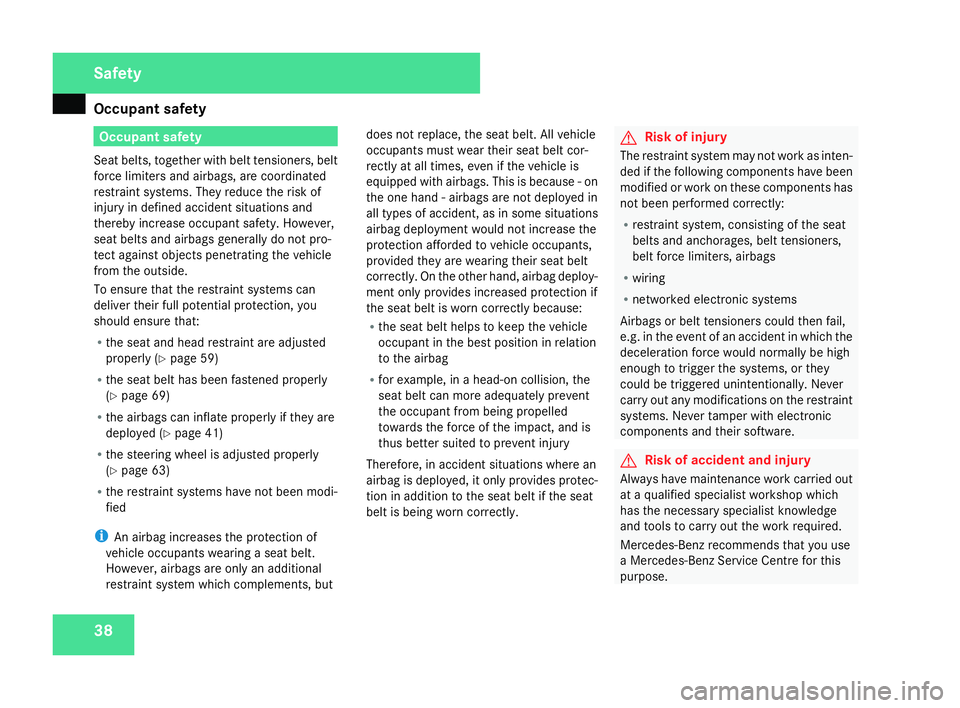
Occupant safet
y38 Occupant safet
y
Seat belts, together with belt tensioners, belt
force limiters and airbags, are coordinate d
restraint systems. They reduce the risk of
injury in defined accident situations and
thereby increase occupant safety. However,
seat belts and airbags generally do not pro-
tect against objects penetrating the vehicl e
from the outside.
To ensure that the restraint systems can
deliver their full potential protection, you
should ensure that:
R the seat and head restraint are adjusted
properly (Y page 59)
R the seat belt has been fastened properl y
( Y page 69)
R the airbags can inflate properly if they ar e
deployed (Y page 41)
R the steering wheel is adjusted properl y
( Y page 63)
R the restraint systems have not been modi-
fied
i An airbag increases the protection of
vehicle occupants wearing a seat belt.
However, airbags are only an additional
restraint system which complements, bu tdoes not replace, the seat belt. All vehicle
occupants must wear their seat belt cor-
rectly at all times, even if the vehicle is
equipped with airbags. This is because - on
the one hand - airbags are not deployed in
all types of accident, as in some situation
s
airbag deployment would not increase th e
protection afforded to vehicle occupants,
provided they are wearing their seat belt
correctly. On the other hand, airbag deploy-
ment only provides increased protection if
the seat belt is worn correctly because:
R the seat belt helps to keep the vehicl e
occupant in the best position in relation
to the airbag
R for example, in a head-on collision, the
seat belt can more adequately prevent
the occupant from being propelle d
towards the force of the impact, and is
thus better suited to prevent injury
Therefore, in accident situations where an
airbag is deployed, it only provides protec-
tion in addition to the seat belt if the seat
belt is being worn correctly. G
Risk of injury
The restraint system may not work as inten-
ded if the following components have bee n
modified or work on these components has
not been performed correctly:
R restraint system, consisting of the seat
belts and anchorages, belt tensioners,
belt force limiters, airbags
R wirin g
R networked electronic system s
Airbags or belt tensioners could then fail ,
e.g. in the event of an accident in which the
deceleration force would normally be high
enough to trigger the systems, or they
could be triggered unintentionally. Never
carry out any modifications on the restraint
systems. Never tamper with electronic
components and their software. G
Risk of accident and injury
Always have maintenance work carried ou t
at a qualified specialist workshop whic h
has the necessary specialist knowledge
and tools to carry out the work required.
Mercedes-Benz recommends that you use
a Mercedes-Benz Service Centre for this
purpose. Safety
171_AKB; 3; 4, en-GB
vpfaff7,
2007-11-13T10:50:25+01:00 - Seite 38
Page 45 of 273
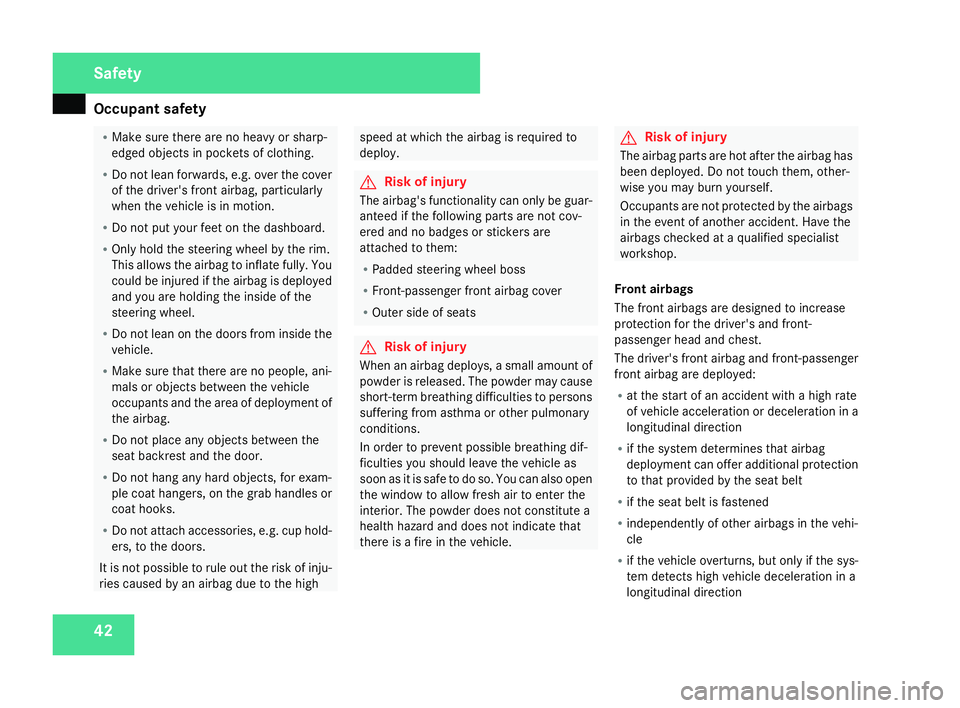
Occupant safet
y42 R
Make sure there are no heavy or sharp-
edged objects in pockets of clothing.
R Do not lean forwards, e.g. over the cove r
of the driver's front airbag, particularly
when the vehicle is in motion .
R Do not put your feet on the dashboard.
R Only hold the steering wheel by the rim.
This allows the airbag to inflate fully. You
could be injured if the airbag is deployed
and you are holding the inside of the
steering wheel.
R Do not lean on the doors from inside the
vehicle.
R Make sure that there are no people, ani-
mals or objects between the vehicle
occupants and the area of deployment of
the airbag.
R Do not place any objects between the
seat backrest and the door.
R Do not hang any hard objects, for exam-
ple coat hangers, on the grab handles or
coat hooks .
R Do not attach accessories, e.g. cup hold -
ers, to the doors.
It is not possible to rule out the risk of inju-
ries caused by an airbag due to the high speed at which the airbag is required to
deploy.
G
Risk of injury
The airbag's functionality can only be guar-
anteed if the following parts are not cov-
ered and no badges or stickers are
attached to them:
R Padded steering wheel boss
R Front-passenger front airbag cover
R Outer side of seats G
Risk of injury
When an airbag deploys, a small amount of
powder is released. The powder may cause
short-term breathing difficulties to persons
suffering from asthma or other pulmonary
conditions .
In order to prevent possible breathing dif-
ficulties you should leave the vehicle as
soon as it is safe to do so. You can also open
the window to allow fresh air to enter the
interior. The powder does not constitute a
health hazard and does not indicate that
there is a fire in the vehicle. G
Risk of injury
The airbag parts are hot after the airbag ha s
been deployed. Do not touch them, other -
wise you may burn yourself.
Occupants are not protected by the airbags
in the event of another accident. Have th e
airbags checked at a qualified specialist
workshop.
Front airbag s
The front airbags are designed to increase
protection for the driver's and front-
passenger head and chest .
The driver's front airbag and front-passenger
front airbag are deployed:
R at the start of an accident with a high rat e
of vehicle acceleration or deceleration in a
longitudinal direction
R if the system determines that airbag
deployment can offer additional protection
to that provided by the seat belt
R if the seat belt is fastened
R independently of other airbags in the vehi-
cle
R if the vehicle overturns, but only if the sys-
tem detects high vehicle deceleration in a
longitudinal direction Safety
171_AKB; 3; 4, en-GB
vpfaff7,
2007-11-13T10:50:25+01:00 - Seite 42
Page 46 of 273
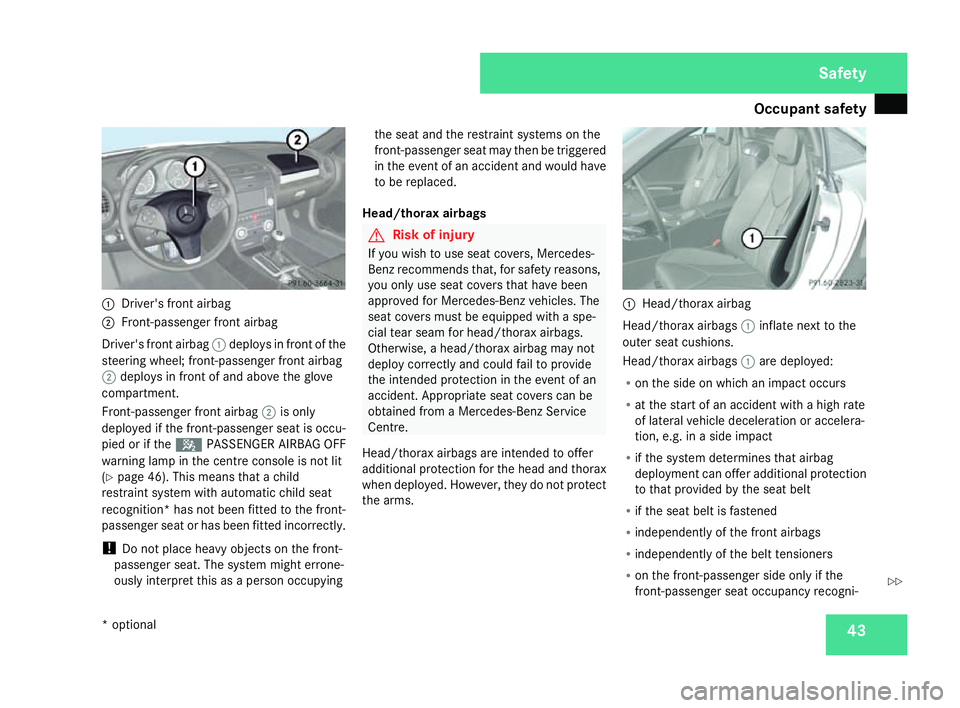
Occupant safet
y 431
Driver's front airbag
2 Front-passenger front airba g
Driver's front airbag 1deploys in front of the
steering wheel; front-passenger front airbag
2 deploys in front of and above the glove
compartment.
Front-passenger front airbag 2is only
deployed if the front-passenger seat is occu-
pied or if the 5PASSENGER AIRBAG OFF
warning lamp in the centre console is not lit
( Y page 46). This means that a child
restraint system with automatic child seat
recognition* has not been fitted to the front-
passenger seat or has been fitted incorrectly.
! Do not place heavy objects on the front-
passenger seat. The system might errone-
ously interpret this as a person occupying the seat and the restraint systems on the
front-passenger seat may then be triggered
in the event of an accident and would have
to be replaced.
Head/thorax airbags G
Risk of injury
If you wish to use seat covers, Mercedes-
Benz recommends that, for safety reasons,
you only use seat covers that have been
approved for Mercedes-Benz vehicles. Th e
seat covers must be equipped with a spe-
cial tear seam for head/thorax airbags.
Otherwise, a head/thorax airbag may not
deploy correctly and could fail to provid e
the intended protection in the event of an
accident. Appropriate seat covers can be
obtained from a Mercedes-Benz Service
Centre .
Head/thorax airbags are intended to offe r
additional protection for the head and thorax
when deployed. However, they do not protect
the arms. 1
Head/thorax airba g
Head/thorax airbags 1inflate next to the
outer seat cushions.
Head/thorax airbags 1are deployed:
R on the side on which an impact occurs
R at the start of an accident with a high rat e
of lateral vehicle deceleration or accelera-
tion, e.g. in a side impact
R if the system determines that airbag
deployment can offer additional protection
to that provided by the seat belt
R if the seat belt is fastened
R independently of the front airbags
R independently of the belt tensioner s
R on the front-passenger side only if the
front-passenger seat occupancy recogni- Safety
* optional
171_AKB; 3; 4, en-GB
vpfaff7,
2007-11-13T10:50:25+01:00 - Seite 43 Z
Page 53 of 273
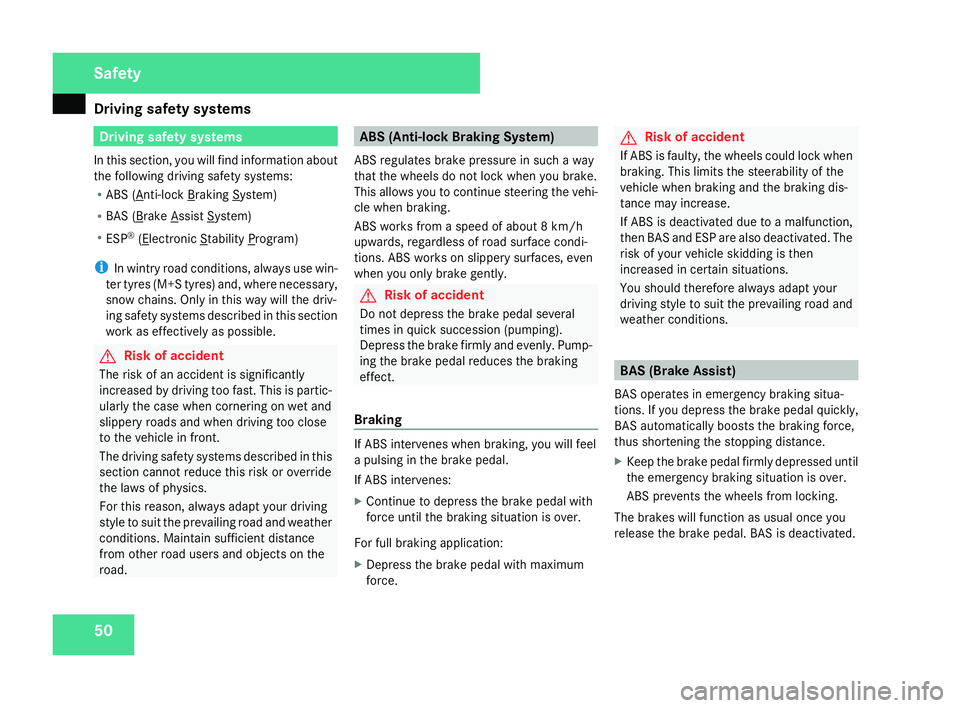
Driving safety sys
tems50 Driving safety systems
In this section, you will find information abou t
the following driving safety systems:
R ABS ( Anti-lock Braking System)
R BAS ( Brake Assist System)
R ESP ®
( Electronic Stability Program)
i In wintry road conditions, always use win-
ter tyres (M+S tyres) and, where necessary ,
snow chains. Only in this way will the driv-
ing safety systems described in this section
work as effectively as possible. G
Risk of accident
The risk of an accident is significantl y
increased by driving too fast. This is partic-
ularly the case when cornering on wet and
slippery roads and when driving too clos e
to the vehicle in front.
The driving safety systems described in thi s
section cannot reduce this risk or override
the laws of physics.
For this reason, always adapt your driving
style to suit the prevailing road and weather
conditions. Maintain sufficient distance
from other road users and objects on the
road. ABS (Anti-lock Braking System)
ABS regulates brake pressure in such a way
that the wheels do not lock when you brake.
This allows you to continue steering the vehi-
cle when braking.
ABS works from a speed of about 8 km/h
upwards, regardless of road surface condi-
tions. ABS works on slippery surfaces, even
when you only brake gently. G
Risk of accident
Do not depress the brake pedal severa l
times in quick succession (pumping) .
Depress the brake firmly and evenly. Pump-
ing the brake pedal reduces the braking
effect.
Braking If ABS intervenes when braking, you will fee
l
a pulsing in the brake pedal.
If ABS intervenes:
X Continue to depress the brake pedal wit h
force until the braking situation is over.
For full braking application:
X Depress the brake pedal with maximum
force. G
Risk of accident
If ABS is faulty, the wheels could lock when
braking. This limits the steerability of the
vehicle when braking and the braking dis-
tance may increase.
If ABS is deactivated due to a malfunction,
then BAS and ESP are also deactivated. The
risk of your vehicle skidding is then
increased in certain situations.
You should therefore always adapt your
driving style to suit the prevailing road and
weather conditions . BAS (Brake Assist)
BAS operates in emergency braking situa -
tions. If you depress the brake pedal quickly,
BAS automatically boosts the braking force,
thus shortening the stopping distance.
X Keep the brake pedal firmly depressed until
the emergency braking situation is over.
ABS prevents the wheels from locking.
The brakes will function as usual once you
release the brake pedal. BAS is deactivated. Safety
171_AKB; 3; 4, en-GB
vpfaff7,
2007-11-13T10:50:25+01:00 - Seite 50